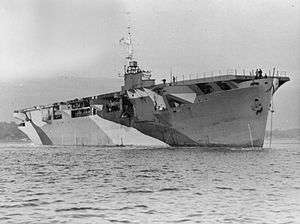Convoy JW 58

Convoy JW 58 was an Arctic convoy sent from Great Britain by the Western Allies to aid the Soviet Union during World War II. It sailed in March 1944, reaching the Soviet northern ports in early April. All ships arrived safely. JW 58 was attacked by German U-boat and air forces, but suffered no losses. Three U-boats were destroyed in counter-measures, and six aircraft shot down, during these operations.
Ships
The convoy consisted of 47 merchant ships which departed from Loch Ewe on 27 March 1944. It also included the US cruiser Milwaukee, which was being transferred to the Soviet navy as part of an agreement over the disposal of the surrendered Italian fleet. The convoy was joined from Iceland by three more ships en route from North America. Close escort was provided by a force led by Lt.Cdr Lambton in the destroyer Westcott. The force comprised two other destroyers and three corvettes. The force was supported by two escort carriers, Activity and Tracker, which travelled with the convoy, and an "Ocean escort" of 17 fleet destroyers led by R.Adm. F. Dalrymple-Hamilton in the cruiser Diadem. In addition, JW 58 was joined by the 2nd Support Group, the RN's most successful anti-submarine warfare group. These were five sloops led by Capt. FJ Walker, in Starling. The convoy was accompanied initially by local escort groups from Britain and Iceland, and joined later by a local escort group from Murmansk. Distant cover was provide by ships of the Home Fleet which were engaged in Operation Tungsten, an air strike against the German battleship Tirpitz anchored in Alta fjord. These were the battleships Duke of York and Anson, the carrier Victorious, cruiser Belfast, and six destroyers under the command of V Adm. Bruce Fraser.
Ranged against this force were the U-boats of the German arctic flotilla, 16 U-boats forming the patrol lines Blitz, Hammer and Thor. German surface forces and air forces were much diminished at this stage of the conflict; Tirpitz was still not operational after damage inflicted by the British X-craft attack (Operation Source), while the German air force was reduced to scouting and shadowing operations.
Action
JW 58 departed Loch Ewe on 27 March 1944, accompanied by its local escort, the minesweeper Rattlesnake and two others, with two corvettes; On 29 March it met Iceland contingent with its escort, the frigate Fitzroy and two A/S minesweepers. These were relieved by the Close escort and Ocean escort forces, and returned to base.
Later during 29 March Starling encountered U-961 in the Norwegian Sea. U-961 was not part of the Arctic flotilla's patrol lines but on passage to North Atlantic; she was unfortunate enough to encounter the RN force, was depth-charged, and destroyed by Starling and Magpie of 2 SG.[1]
On 31 March JW 58 met first patrol line. Over the next 48 hours the U boat force mounted 18 attacks on the convoy. No ships were hit, but three U-boats were destroyed. On 31 March the U-boats mounted their first attacks; they had no success but U-355 was destroyed by Beagle and aircraft from Tracker.[2][3]
On 2 April in another encounter Keppel destroyed U-360 in a hedgehog attack.[4]

On 3 April a Swordfish from Activity attacked U-288 and, with help from a Marlet and Avenger team from Tracker, destroyed her.[5]
On 3 April also JW 58 was joined by the eastern local escort, four Soviet destroyers, and on 4 April arrived at Kola without further incident.
Conclusion
With the safe arrival of so many ships, and the destruction of three U-boats, plus a fourth incidental kill, and six shadowing aircraft, JW 58 was one of the most successful Arctic convoys run by the Allies during World War II. JW 58 was the last Arctic convoy for several months. The sequence was discontinued during summer 1944 as all naval forces were required for Operation Neptune, the cover for the Normandy landings. It re-commenced in August 1944 with Convoy JW 59.
Decorations to those taking part in JW 58 were announced on July 18, 1944 [6]
Notes
References
- Clay Blair : Hitler's U-Boat War Vol 2 (1998) ISBN 0-304-35261-6
- Paul Kemp : Convoy! Drama in Arctic Waters (1993) ISBN 1-85409-130-1
- Paul Kemp : U-Boats Destroyed ( 1997) . ISBN 1-85409-515-3
- Axel Neistle : German U-Boat Losses during World War II (1998). ISBN 1-85367-352-8
- Bob Ruegg, Arnold Hague : Convoys to Russia (1992) ISBN 0-905617-66-5
- Bernard Schofield : (1964) The Russian Convoys BT Batsford OCLC 862623
- JW 58 at Convoyweb
Coordinates: 73°43′48″N 27°12′00″E / 73.7300°N 27.2000°E